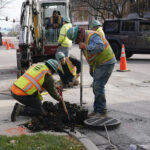Sen. Kyrsten Sinema (I-AZ) is running out of time to launch a reelection bid in Arizona with a little over a month until a critical signature-filing deadline.
The time frame to make the ballot was cut short by a week after the legislature moved up the date in recent weeks to avoid election deadline issues, putting more pressure on Sinema to make up her mind about seeking another six-year term.
Sinema left the Democratic Party a little over a year ago to become an independent. If she doesn’t call it quits, she’ll enter a three-way race with progressive Rep. Ruben Gallego (D-AZ), the likely Democratic nominee, and Kari Lake, who is the front-running Republican candidate for the U.S. Senate.
To appear on the ballot as an independent, Sinema originally would have needed to gather 42,303 signatures by April 8. However, due to new rules passed by the state legislature to ensure its electoral votes are counted, the deadline is now April 1. She has yet to file her statement of interest with the Arizona Secretary of State’s Office in order to begin gathering qualified signatures.
“We’re to the point where you can’t look at yourself in the mirror and say if you want to be on the ballot, let’s keep waiting,” said Jon Sutton, who runs a Democratic consulting firm in Arizona that gathers signatures. “There’s no logical reason to still be waiting if she is intending to run as an independent. I couldn’t see any practical reason previously. I very definitely don’t see a practical reason. I think we are past the Rubicon.”
Sutton believes Sinema would need to get about 63,000-65,000 signatures to ensure enough would be accepted. That could come with a price tag of a million dollars. While she could gather signatures electronically, Sutton said barriers exist that would prevent her from meeting that benchmark with digital signatures alone.
“Those signatures are great because you know they are valid, but at this volume she needs, she is going to have to hit the pavement just because of the scale of what’s required there,” Sutton explained in an interview with the Washington Examiner.
ELECTION 2024: FOLLOW LATEST COVERAGE
With such a tight deadline, Sutton said Sinema would likely need to bring in out-of-state help since firms that do this kind of work in Arizona are likely booked up doing other projects.
“Maybe it’s an out-of-state firm she would hire. Again, I do think there’s a small pool of people in the state that would accept this work,” he said. “You’d have to parachute people in, which is expensive or they’d have to hire locally, but they don’t have existing employees, existing infrastructure.”
Sinema’s campaign recently reported the worst fundraising quarter this election cycle, collecting $595,000 in the last quarter, the lowest since the beginning of 2021. The fundraising total is less than one-fifth of what Gallego raised in the same period. However, she still has $10.6 million cash on hand, the most of any of her prominent challengers, but that figure has not changed much over the past year.
After the bipartisan immigration deal that Sinema helped negotiate failed in the Senate, some believe it’s the perfect time for her to announce her retirement.
“I think following the failure of the immigration bill, she’s got the ready-made excuse to say, ‘I’m throwing up my hands, this place is desperately broken, and I don’t want to be part of it anymore,’” said Chuck Coughlin, a longtime Arizona operative who is the CEO and founder of the Phoenix-based firm HighGround.
Registered voters in the state are 34% Republican, 34% independent, and 30% Democratic, according to Arizona data. Sinema’s political path as a third-party candidate without the help of party infrastructure during an election year is something that many experts in the state predict would be a major uphill climb.
There are some signs the senior Arizona senator was preparing to launch a bid. An internal memo surfaced toward the end of 2023 in which her team laid out a path to winning a second term, judging that the Arizona independent would need to win between 10% and 20% of Democrats, 25% to 35% of Republicans, and about 60% to 70% of independent voters. Coughlin believes it would be difficult for her to get that percentage of Democrats behind her.
“That’s a tall order given the fact that she’s offended that base fairly deeply by her provocative way in which she left the party,” Coughlin said. “Independents also are not a base of voters that you want to build a campaign around because of their individualism.”
CLICK HERE TO READ MORE FROM THE WASHINGTON EXAMINER
“It’s just a very difficult thing to do to build that electoral coalition. It’s like you start the election with 40% of the electorate telling you to go pound sand,” Coughlin added.
Sinema’s office did not respond to a request from the Washington Examiner for comment.






